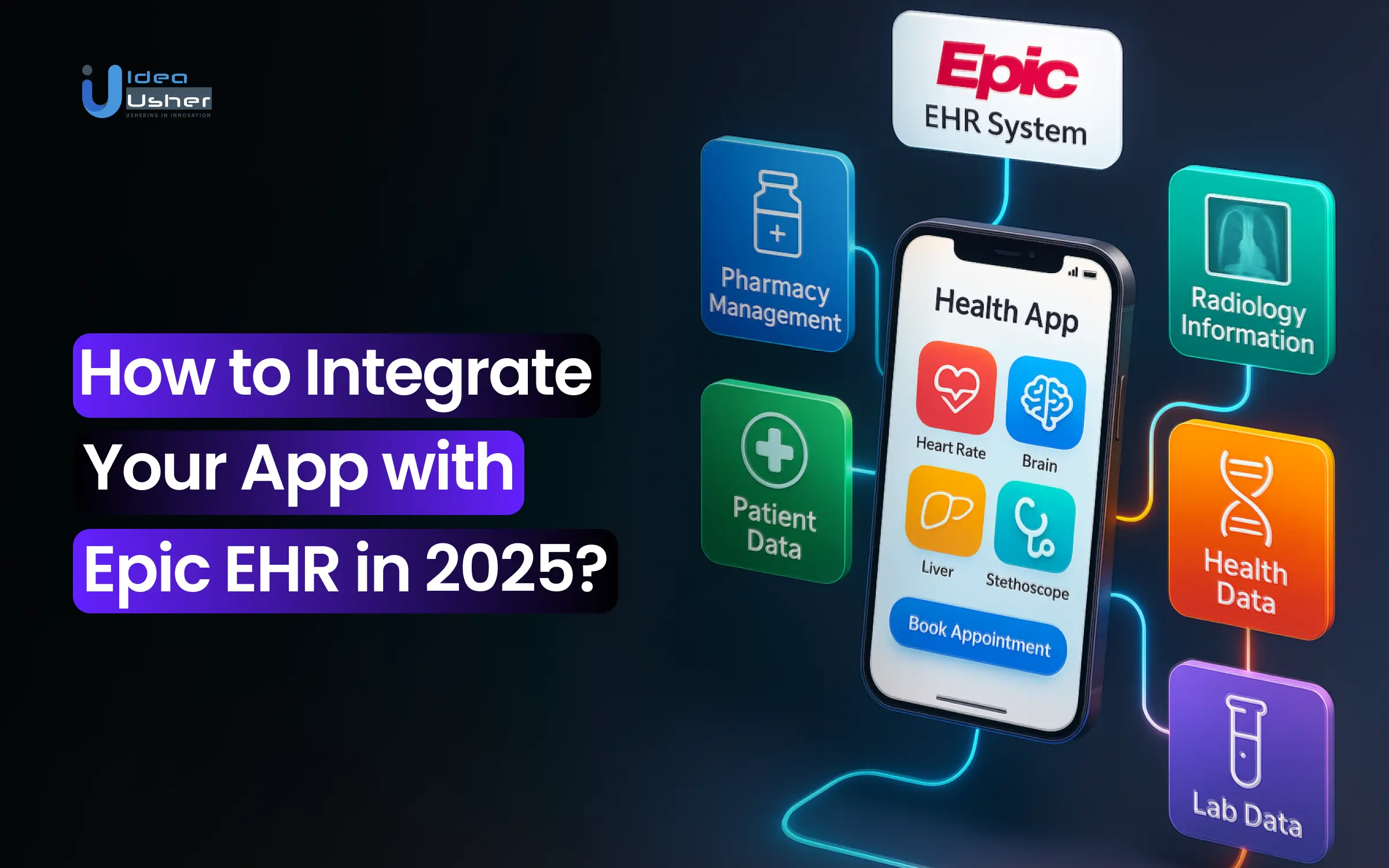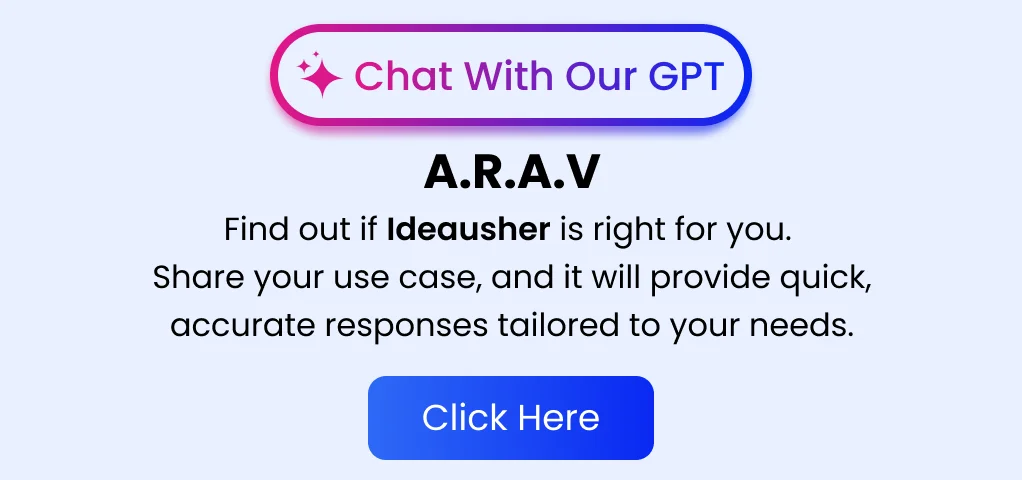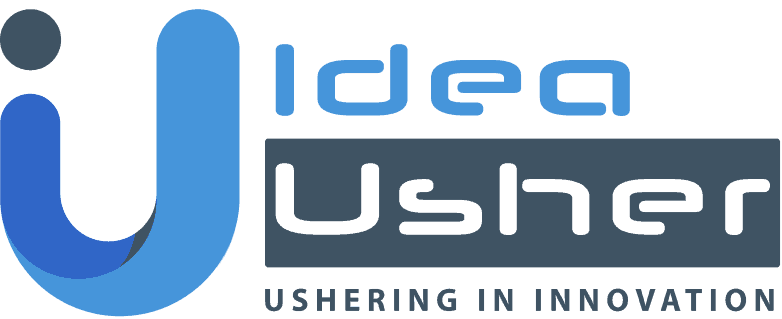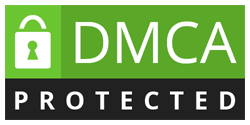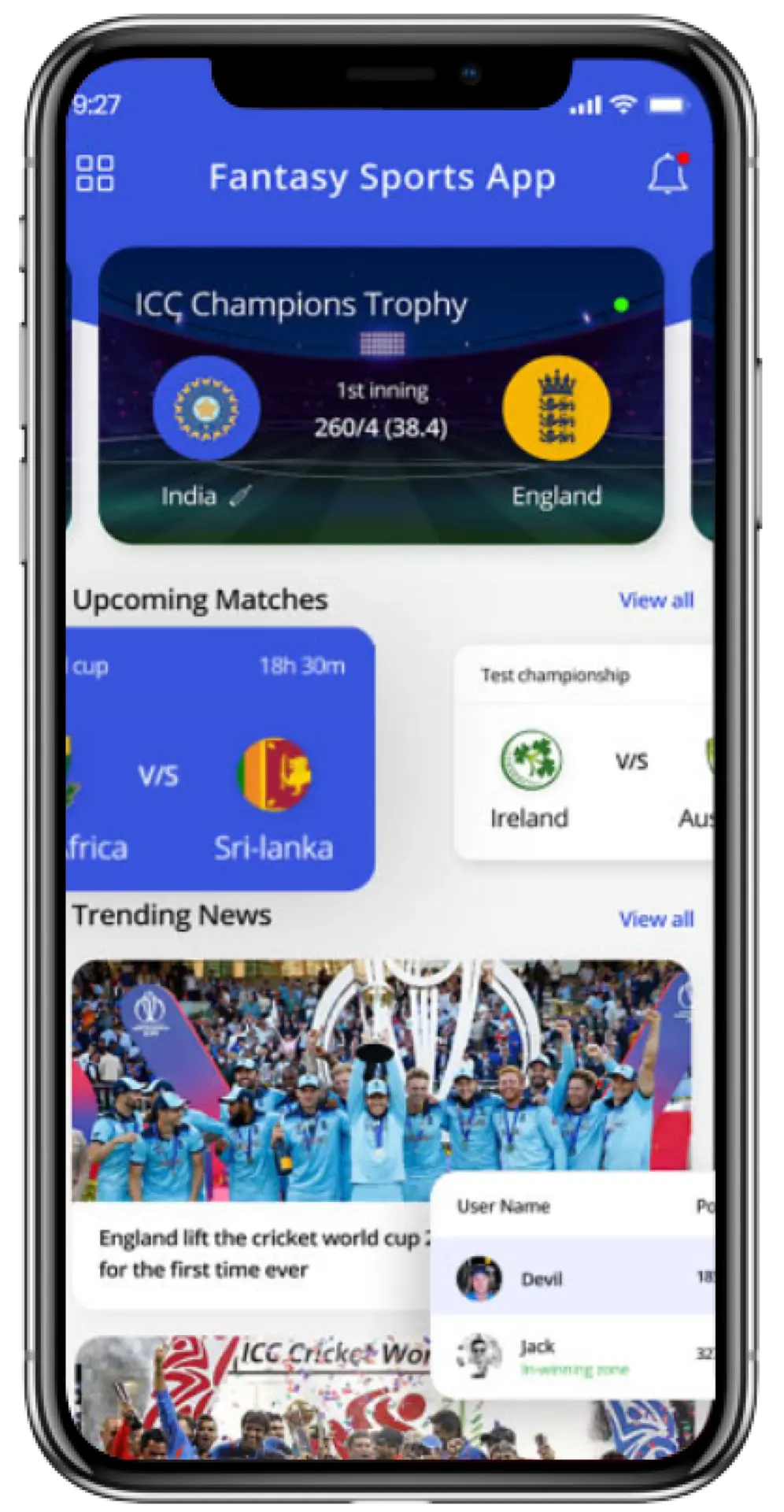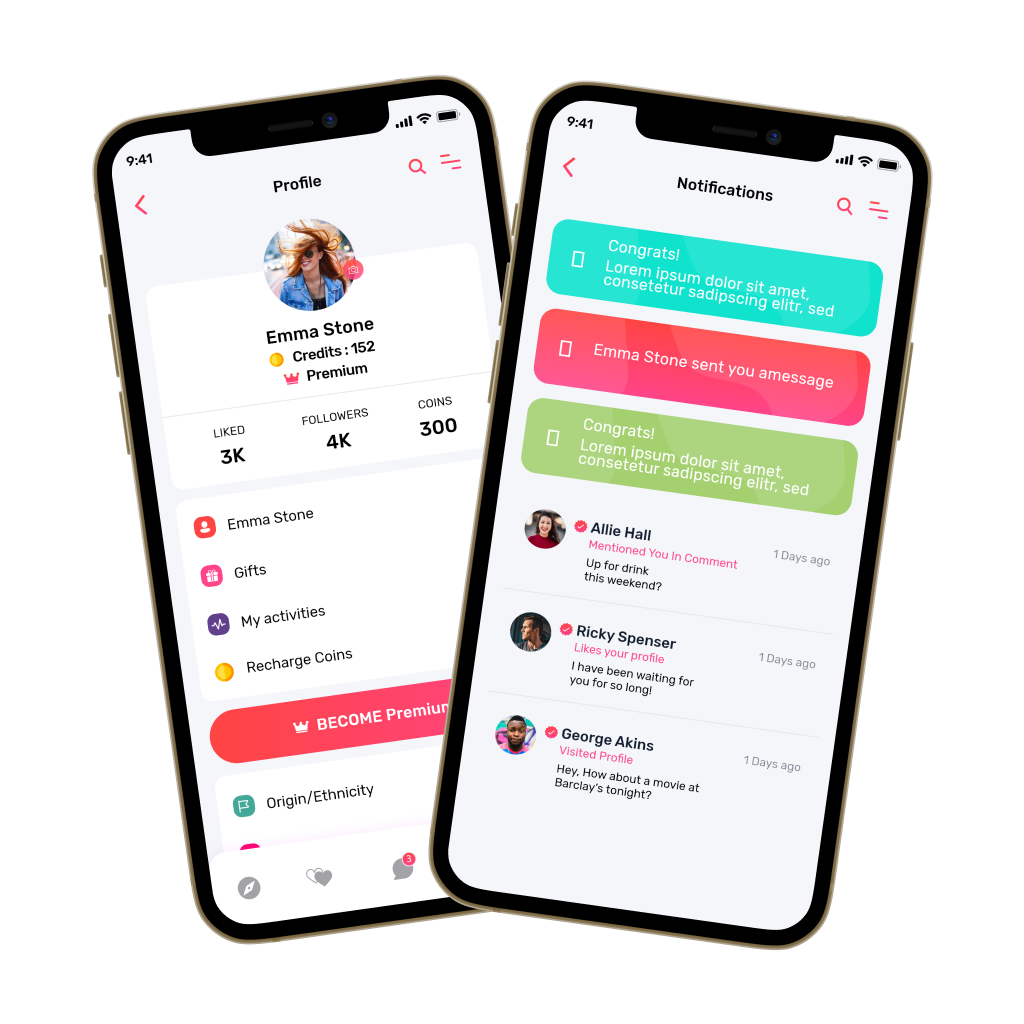Epic EHR (Electronic Health Record) is one of the most widely used systems in healthcare, offering a comprehensive platform for managing patient data, scheduling, and clinical workflows. Integrating your app with this cloud-based health information system provides significant benefits, including seamless access to patient information, improved clinical decision-making, and enhanced patient care. However, integrating with Epic EHR can be a complex process due to its robust architecture and the need for compliance with healthcare regulations.
In this blog, we will talk about how to integrate your app with Epic EHR in 2025. We will explore the steps involved in the integration process, key challenges you may face and how our developers will solve those as we have developed many healthcare apps with numerous companies and IdeaUsher has the expertise to integrate Epic EHR in your healthcare app so that healthcare institutes can follow best practices for ensuring smooth and secure data exchange with Epic’s ecosystem.

Why You Should Invest in Healthcare Apps with Epic EHR Integration?
According to Grand View Research, the global electronic health records (EHR) market size was estimated at USD 33.43 billion in 2024 and is projected to reach USD 43.36 billion by 2030, growing at a CAGR of 4.54% from 2025 to 2030.
Epic Systems: A Dominant Player in the EHR Market
Epic Systems is a key leader in the EHR market, with over 305 million patients having their health records in Epic. The company reported $4.9 billion in revenue for 2023, reflecting a 7% increase from the previous year. Epic is privately held, and while it has not publicly disclosed specific funding rounds, its consistent revenue growth and industry dominance demonstrate the robust nature of the company.
1upHealth, a healthcare platform focused on integrating patient data from multiple sources, has raised $80.3 million over several funding rounds. This funding highlights the growing investor interest in healthcare apps that streamline data interoperability, enabling healthcare providers to offer better patient care through enhanced data access.
Magical, a productivity app for streamlining workflows, secured $41 million in funding, including a $35 million Series A round led by Coatue. The platform’s consistent growth and integration with enterprise-level solutions demonstrate the increasing demand for AI-driven tools that optimize work processes.
Amwell, a leader in telemedicine and healthcare technology, has raised a total of $887 million over 13 funding rounds, with $742 million raised during its IPO. This funding has fueled its growth and expansion into key markets, enhancing its ability to provide innovative healthcare solutions.
Investing in healthcare apps that integrate with Epic EHR presents a significant opportunity. Epic’s market dominance and rising demand for EHR integration highlight the growth potential in this sector. With companies like 1upHealth, Magical, and Amwell leading the way, investors can expect substantial returns in these transformative healthcare technologies.
What is Epic EHR?
Epic EHR is a cloud-based, integrated health information system designed to manage various aspects of patient care. It combines the functionalities of Electronic Medical Records (EMR) and Electronic Health Records (EHR), offering a unified platform that supports clinical, administrative, and financial operations within healthcare organizations.
Overview of Epic Systems as an EHR Provider
Epic Systems is a leading EHR provider known for its comprehensive, user-friendly healthcare solutions.
- Comprehensive EHR Platform: Epic Systems provides a comprehensive EHR platform that integrates clinical, administrative, and financial data, aiming to improve patient outcomes, streamline operations, and enhance healthcare delivery across diverse healthcare settings.
- Customizable Solutions: Epic Systems offers flexible EHR solutions, catering to healthcare providers of all sizes, from small clinics to large academic medical centers, allowing customization to meet specific organizational needs effectively.
- Improved Care Coordination: Epic’s EHR facilitates seamless patient data sharing and access across various healthcare settings, ensuring better care coordination, reducing medical errors, and enhancing the continuity of care across the healthcare continuum.
- Wide Adoption Across Healthcare Organizations: Epic’s EHR platform is widely adopted by diverse healthcare organizations, including hospitals, ambulatory clinics, long-term care facilities, and mental health facilities, ensuring comprehensive integration across the healthcare ecosystem.
- Interoperability Features: Epic’s EHR includes interoperability features that enable smooth patient data exchange with other healthcare systems, ensuring continuity of care and reducing gaps in medical information as patients transition across different care settings.
- Patient Engagement Tools: Epic provides patient engagement tools such as patient portals, mobile apps, and telehealth capabilities, allowing patients to access health data, manage appointments, and easily communicate with their healthcare providers.
Key Components and Modules of Epic Used by Healthcare Enterprises
Epic’s EHR system is modular, meaning that healthcare organizations can choose specific components or functionalities based on their needs. Some key modules and components of Epic used by healthcare enterprises include:
1. EpicCare Ambulatory
This module is designed for outpatient clinics and primary care settings. It provides a comprehensive suite of tools for patient management, clinical decision support, and care coordination. It allows clinicians to manage patient information, document visits, and track patient progress.
Features:
- Scheduling and appointment management
- Electronic prescribing (e-prescribing)
- Lab results and diagnostic imaging integration
- Clinical documentation and decision support
- Patient portal access for communication and follow-up
2. EpicCare Inpatient
EpicCare Inpatient is tailored for hospital inpatient settings. It provides real-time access to patient data, helping healthcare professionals make informed decisions and deliver better care. This module enables doctors and nurses to document patient progress, order medications, and track patient treatments
Features:
- Bedside clinical documentation
- Medication administration records (MAR)
- Order entry for lab tests, imaging, and medications
- Decision support and alerts for critical values
- Patient monitoring and tracking tools for care teams
3. Epic Willow (Pharmacy Management)
This module is designed to manage pharmacy workflows, including medication ordering, dispensing, and inventory control. Epic Willow helps ensure that medications are safely prescribed and administered.
Features:
- Medication order management
- Pharmacy inventory tracking
- Medication barcode scanning and verification
- Integration with clinical systems to monitor drug interactions
- Controlled substance tracking and compliance
4. Epic Beaker (Laboratory Management)
Epic Beaker is a laboratory information system (LIS) that allows healthcare organizations to manage lab operations efficiently, including specimen collection, test ordering, and result reporting.
Features
- Lab order entry and result reporting
- Integration with EpicCare for seamless clinical workflows
- Quality control and regulatory compliance tools
- Electronic lab result transmission to healthcare providers
- Barcode labeling for specimen tracking
5. Epic Radiant (Imaging and Radiology)
This module is designed for managing imaging workflows within healthcare enterprises, enabling radiologists to order, review, and report on imaging studies like X-rays, MRIs, CT scans, and ultrasounds.
Features:
- Image ordering and result reporting
- Radiology workflow management
- Integration with the broader Epic EHR for viewing images alongside clinical notes and results
- Teleradiology support for remote diagnosis
- Automated alerts for critical imaging results
6. Epic MyChart (Patient Portal)
Epic MyChart is a patient engagement tool that allows patients to access their health information, communicate with providers, schedule appointments, and view test results. MyChart promotes active patient involvement in their healthcare.
Features:
- Secure messaging with healthcare providers
- Appointment scheduling and reminders
- Access to lab results and prescriptions
- Health record review and management (medications, allergies, immunizations)
- Telehealth functionality for virtual appointments
7. Epic Cadence (Scheduling and Patient Flow)
This module streamlines scheduling for patients and providers, optimizing the appointment booking process, managing patient flow, and ensuring operational efficiency.
Features:
- Real-time appointment scheduling and management
- Resource management (e.g., exam rooms, specialists)
- Integration with patient history and clinical needs
- Automated reminders and confirmations
- Queue management for reducing patient wait times
8. Epic Radiology and Imaging (Imaging Workflow)
Epic’s imaging module, Radiant, integrates radiology images directly into the EHR, allowing healthcare professionals to review and interpret results without leaving the platform.
Features:
- Direct integration with imaging equipment
- Efficient image viewing and reporting tools
- Compatibility with third-party imaging systems
- DICOM (Digital Imaging and Communications in Medicine) standards support
- Image annotation and collaboration tools
9. Epic Care Everywhere (Interoperability)
This is Epic’s interoperability platform, allowing healthcare organizations to share patient data with other healthcare providers or institutions that use different EHR systems.
Features:
- Secure data exchange with external systems
- Access to patient health records across various care
- Compliance with data sharing standards such as HL7 and FHIR
- Remote access to records for care continuity and coordination
What is FHIR?
FHIR (Fast Healthcare Interoperability Resources) is a modern standard for exchanging healthcare information electronically. Developed by HL7 (Health Level 7), FHIR is designed to simplify the way healthcare data is shared and integrated across systems, such as Electronic Health Records (EHRs), apps, and other healthcare applications.
Key aspects of FHIR include:
- RESTful APIs: FHIR uses RESTful web services, enabling data retrieval via HTTP requests, which makes it easy to integrate with other healthcare applications.
- Standardized Data Formats: Data is exchanged using widely adopted formats like JSON or XML, which simplifies integration with modern web technologies.
- Support for Multiple Data Types: FHIR covers a wide variety of healthcare data, from clinical information like diagnoses and medications to administrative data like billing and scheduling.
- Security and Privacy: FHIR includes built-in features to ensure data security and comply with regulations like HIPAA in the U.S., making it suitable for use in healthcare environments.
How SMART on FHIR Enables App Integration with EHRs like Epic?
SMART on FHIR is an open standard that allows third-party applications to securely integrate with EHR systems like Epic Systems. It simplifies the connection process between external apps and clinical systems, enabling secure and standardized data exchange while leveraging FHIR to access specific healthcare resources.
1. OAuth 2.0 Authentication
SMART on FHIR uses OAuth 2.0 for secure authorization, enabling users to grant external apps access to health data within EHR systems without compromising credentials. For example, a clinician can securely access patient data like medical history via OAuth 2.0.
2. Access to FHIR Resources
Through SMART on FHIR, third-party apps access essential FHIR resources like patient demographics, medication lists, and observations. For example, a mobile app integrated with Epic can fetch real-time data to update clinical records, improving workflow and clinical decision-making.
3. Secure Data Sharing
SMART on FHIR ensures secure data exchange, encrypting transactions between apps and EHRs, maintaining compliance with regulations like HIPAA. For instance, apps can securely update patient data, enhancing collaboration among healthcare providers, leading to better patient outcomes and coordinated care.
4. Interoperability with Existing EHRs
SMART on FHIR enhances interoperability, enabling seamless Epic EHR integration. For example, a clinical decision support tool built on SMART on FHIR can pull real-time data from Epic, providing evidence-based recommendations while integrating smoothly into existing workflows.
5. Modular and Extensible Applications
SMART on FHIR allows for modular apps, easily integrated into existing EHR systems. For instance, healthcare organizations can deploy apps for medication tracking or telemedicine, tailored to their specific needs, which can be smoothly added to Epic’s interface for enhanced functionality.
6. Scalability and Innovation
Built on FHIR, SMART on FHIR supports scalability for mobile devices, cloud apps, and analytics tools. This flexibility allows developers to integrate innovative solutions, like AI-powered clinical decision tools, while ensuring smooth compatibility with existing EHR systems, such as Epic.
Why These Standards Matter in 2025?
As we approach 2025, healthcare systems are relying more on data interoperability and patient-centered care. Technologies like FHIR and frameworks like SMART on FHIR are vital for improving data exchange, encouraging innovation, and meeting regulatory standards, thereby enhancing healthcare efficiency and quality.
1. Regulatory Compliance
The Cures Act Final Rule requires healthcare organizations to ensure patient access to health data and promote interoperability. FHIR helps comply with these regulations by enabling seamless data exchange, reducing information blocking, and allowing third-party apps to interact with healthcare systems, ensuring transparency and data sharing.
Example: Under the Cures Act, hospitals and clinics using Epic EHR must enable patient access to health records through FHIR-based APIs and allow data sharing with third-party apps, utilizing standards like SMART on FHIR for secure connections.
2. Seamless Data Exchange and Patient-Centered Care
Seamless data exchange, enabled by FHIR and interoperable standards, is essential for patient-centered care. It ensures continuity of care across settings, providing healthcare providers with a complete health picture, improving decisions, patient engagement, and ultimately enhancing outcomes and satisfaction.
Example: A patient portal using SMART on FHIR can pull data from EHRs like Epic or Cerner, enabling patients to view lab results, track medications, schedule appointments, and consult with specialists. This access enhances patient empowerment and puts them at the center of their healthcare experience.
3. Enabling Third-Party Innovation
FHIR and SMART on FHIR foster innovation by allowing third-party developers to integrate secure, real-time apps into EHR systems. These apps enhance care delivery, streamline workflows, support decision-making, and improve patient outcomes, optimizing healthcare processes without disruption.
Example: A developer could create a telemedicine app that integrates with Epic EHR via SMART on FHIR. This app would provide real-time patient data, enabling healthcare providers to conduct informed virtual consultations. This integration improves access to care and enhances care quality.
Benefits of Epic EHR Integration
Integrating with Epic EHR provides essential benefits for businesses and healthcare organizations, enhancing patient outcomes and operational efficiency. Connecting your app or service to Epic leverages its widespread use, valuable data resources, and secure protocols. Here are the key advantages of this integration.
A. Business Advantages
Exploring the business advantages reveals how these strategies enhance operational efficiency, reduce costs, and improve overall service delivery.
1. Access to Epic’s Vast Provider Network
Epic EHR integration provides access to a vast network of healthcare organizations, including hospitals and outpatient clinics. For example, integrating a telemedicine app with Epic allows seamless adoption by organizations already using Epic, increasing visibility and enhancing interoperability across healthcare providers.
2. Increased Trust and Value Proposition for Your App
Integrating with Epic enhances your app’s credibility, showing it meets high standards of data security, privacy, and healthcare compliance. For example, an app integrated with Epic gains trust from healthcare providers, making it easier for organizations to adopt it within their existing Epic systems.
3. Real-Time Clinical Data Access for Better Patient Outcomes
Epic EHR integration enables access to real-time clinical data, enhancing the quality of patient care. For instance, a clinical decision support tool integrated with Epic can provide real-time, evidence-based treatment recommendations, improving decision-making and patient outcomes by using up-to-date patient information.
B. Technical Advantages
The technical advantages highlight how advanced technologies improve system performance, streamline operations, and ensure secure, scalable solutions.
1. Secure Authentication via OAuth 2.0
Epic EHR integration uses OAuth 2.0 authentication protocols to ensure secure interaction with Epic EHR systems. For example, when a user logs into your app with their Epic account, OAuth 2.0 securely validates their credentials, granting authorized access to their healthcare data.
2. Standardized APIs Reduce Integration Overhead
With Epic EHR integration, standardized APIs via SMART on FHIR simplify app integration. For example, a patient engagement app can quickly access Epic’s patient data, enabling users to view records, schedule appointments, and communicate with providers without custom integration solutions.
3. Scalability for Multiple Epic Clients
Epic EHR integration offers scalability, allowing your app to serve various healthcare organizations. For example, a clinical analytics app integrated with Epic can work across large systems or small clinics, ensuring consistent data analysis and informed decision-making, regardless of the organization’s size.

Step-by-Step Process to Integrate Your App with Epic EHR
Integrating your application with Epic EHR involves understanding Epic’s developer ecosystem and selecting the appropriate integration approach. You’ll need to set up your development environment, build and authenticate your app, validate the integration, and then deploy it. Here’s a concise breakdown of the integration process.
Step 1: Consultation and Understand Epic App Orchard
We will consult with Epic’s team to discuss your app’s use case, ensuring alignment with Epic’s ecosystem and access to Epic EHR integration. After signing up for App Orchard, we’ll gain access to tools like FHIR APIs and SMART on FHIR protocols. Our goal is to ensure your app meets certification requirements and adheres to healthcare interoperability standards.
Step 2: Choose Integration Approach
For optimal Epic EHR integration, we’ll assess the type of data your app requires. If your app needs lightweight data exchange, we’ll use FHIR APIs. For deeper integration with patient data and workflows, SMART on FHIR will be used. We will also consider HL7 for compatibility with legacy systems, ensuring seamless integration across platforms.
Step 3: Set Up a Development Environment
After gaining access to the Epic sandbox environment, we’ll test Epic EHR integration using test patients and validate FHIR resources. We will configure OAuth 2.0 credentials for secure authentication, ensuring compliance with HIPAA regulations. Testing FHIR endpoints will help us ensure accurate data retrieval and smooth interaction between your app and Epic systems.
Step 4: Build and Authenticate Your Application
We’ll implement the SMART on FHIR launch sequence, enabling your app to authenticate via Epic EHR integration and retrieve patient data. User roles, permissions, and patient data access will be defined, adhering to data privacy standards. The app will be optimized to handle sensitive healthcare data securely while maintaining a smooth user experience.
Step 5: Validate and Test Your Integration
Testing Epic EHR integration with Epic’s test patients will allow us to verify that your app retrieves, updates, and displays patient data correctly. We’ll ensure error handling for connection issues, check app performance for speed, and confirm HIPAA compliance. Any integration issues will be addressed before proceeding to deployment.
Step 6: Deploy, Monitor, and Optimize
After submission to the Epic App Market, we’ll monitor app performance for any synchronization issues or lag in real-time data exchange. Continuous analytics and logging will be implemented to track usage, ensuring that the app remains secure and compliant post-launch. Optimization will be an ongoing process based on user feedback and performance data.
Common Challenges and How to Overcome Them?
Integrating with Epic EHR and other healthcare systems presents various technical and operational challenges, including authentication issues, data access limitations, and regulatory compliance. Here, we outline common integration challenges and strategies to effectively address them.
1. Authentication and Scope Errors
Challenge: Authentication errors arise from improper OAuth 2.0 configurations or expired credentials, leading to failed user authorizations or insufficient access to Epic’s EHR data. Incorrect scope definitions or role assignments can further complicate this issue.
Solution: To solve this, we will ensure a correct OAuth 2.0 setup by only requesting the necessary scopes and roles. We’ll implement error handling systems that automatically retry failed authentications and guide users through re-authentication processes. Additionally, we’ll test authentication flows regularly using Epic’s sandbox environments to ensure smooth operation.
2. Data Access Limitations
Challenge: Healthcare providers or patients may restrict access to specific data, such as lab results or medication history, based on privacy settings or permissions, leading to difficulties in retrieving essential patient data for the app.
Solution: We will ensure clear permissions and scopes are defined in the app, only requesting the necessary data. If certain data types are restricted, we’ll build flexible data models that allow partial data access and implement fallback mechanisms for manual data input or syncing from other sources when needed.
3. Performance Bottlenecks
Challenge: Large datasets or high traffic can cause performance bottlenecks, leading to sluggish data retrieval and slow response times, impacting the app’s user experience and overall performance when integrated with Epic.
Solution: We will optimize API calls by caching frequently accessed data and using asynchronous operations for longer queries. Additionally, we’ll conduct load testing using tools like JMeter to simulate peak traffic and pinpoint performance bottlenecks, ensuring the app performs efficiently under heavy data loads and traffic.
4. Regulatory Compliance and Security
Challenge: Ensuring compliance with HIPAA and other security regulations is vital for healthcare apps to protect patient data and maintain trust. Security violations or non-compliance can lead to legal repercussions and loss of user confidence.
Solution: We will implement industry-standard security protocols such as TLS encryption for communication and AES encryption for storing sensitive data. We’ll ensure compliance with HIPAA by following best practices, conduct regular security audits, and leverage Epic’s compliance tools to ensure the app meets security and privacy standards.
5. Scalability and Multi-EHR Support
Challenge: As healthcare systems scale, apps integrated with Epic may face challenges in supporting a growing number of healthcare organizations and varying patient needs. Supporting multiple EHR systems adds complexity to the app’s architecture.
Solution: We will design a modular architecture that supports scalable growth, ensuring the app can handle more Epic clients or integrate with other EHR systems. By adhering to FHIR standards and leveraging SMART on FHIR, we will ensure interoperability. We will also use cloud infrastructure with auto-scaling to manage traffic and data storage efficiently as the user base grows.
Tools, APIs, and Frameworks Required for Integrating with Epic EHR
When integrating your application with Epic EHR, various tools, APIs, and frameworks are necessary to ensure smooth interaction, data security, and compliance. Below is a comprehensive list of the essential tools, APIs, and frameworks you will need throughout the integration process.
1. Epic App Orchard
Epic App Orchard is the official developer platform and marketplace for integrating third-party apps with Epic’s EHR systems. It provides access to various resources, including APIs, developer tools, and documentation to help developers build, test, and deploy applications within the Epic ecosystem.
Key Features:
- Sandbox Environments: Access to test environments that mimic real-world healthcare workflows.
- FHIR API Access: Secure access to Epic’s FHIR-based APIs for retrieving clinical data such as patient records, medications, and lab results.
- App Marketplace: A platform for developers to distribute their apps to healthcare organizations that use Epic
2. SMART on FHIR
SMART on FHIR is an open standard built on top of FHIR (Fast Healthcare Interoperability Resources) that enables third-party applications to integrate securely with Electronic Health Record (EHR) systems like Epic. This standard ensures that applications can access clinical data via RESTful APIs and maintain security and privacy during data exchange.
Key Features:
- OAuth 2.0 Authentication: Ensures secure user login and authorization.
- FHIR Resource Access: Facilitates access to patient data and other clinical information using FHIR resources such as Patient, Observation, Medication, etc.
- Modular Framework: Allows healthcare apps to be modular and interact with Epic’s EHR system seamlessly.
3. HL7 FHIR API
FHIR API is the core set of RESTful APIs that allow third-party apps to access and exchange healthcare data in a standardized format. It is based on the FHIR standard and provides secure and standardized access to clinical data such as patient demographics, medication lists, lab results, encounters, and more.
Key Features:
- FHIR Resources: APIs access patient data and other clinical information using FHIR resources such as Patient, Observation, Medication, Encounter, etc.
- RESTful Access: Provides a modern, lightweight interface for communicating with EHR systems.
- JSON and XML Formats: Data is exchanged using standardized formats like JSON or XML for easy integration with web and mobile applications.
4. OAuth 2.0
OAuth 2.0 is the industry standard for secure authorization and authentication of users, ensuring that third-party apps can access Epic’s data without compromising user credentials. It allows your app to access patient data securely by obtaining user consent through a token-based system.
Key Features:
- Token-Based Authentication: Users authenticate once, and apps can use tokens for secure access to their data.
- Scopes: OAuth allows apps to request specific scopes of access, such as viewing patient data, writing notes, or accessing medication lists.
- Single Sign-On (SSO): OAuth 2.0 supports single sign-on for users across various platforms, simplifying the user experience.
5. Postman or FHIR Clients
Postman and other FHIR clients are essential tools for testing your app’s integration with Epic’s APIs. These tools allow you to simulate API calls, check the correctness of responses, validate integration workflows, and troubleshoot issues in a controlled environment before deployment.
Key Features:
- Test API Endpoints: Use Postman or FHIR clients to make GET, POST, PUT, or DELETE requests to test your integration.
- Data Validation: Validate the format and structure of the FHIR resources returned by Epic’s EHR system.
- Error Handling: Helps simulate error responses and determine how your app will handle them.
Use Case: Patient Engagement App Integration with Epic
A digital health company plans to integrate its mobile patient engagement platform with Epic EHR, allowing patients to access real-time appointment data, prescription refills, and lab results on their mobile devices. This integration aims to enhance patient control, improve engagement, and streamline communication with healthcare providers.
Process Overview:
- Registered on App Orchard: The team registered the app on Epic’s App Orchard, gaining access to Epic’s developer tools and APIs.
- Built SMART on FHIR-Compatible Mobile App: The app was developed to be SMART on FHIR-compatible, enabling secure access to patient data.
- Configured Authentication for Patient-Facing Data: Implemented OAuth 2.0 authentication for secure, patient-facing data access.
- Successfully Connected to Epic’s Sandbox and Passed Security Tests: The integration was tested in Epic’s sandbox environment, and the app passed stringent security and compliance tests
- Launched within 4 Months, Achieving 40% Higher Patient Retention Rate: The app was launched in four months, and saw a 40% higher patient retention rate due to seamless access to health data.
Conclusion
Integrating your app with Epic EHR in 2025 presents an opportunity to enhance healthcare delivery through seamless data exchange and improved patient care. By ensuring compatibility with Epic’s robust infrastructure, healthcare apps can provide real-time access to critical information, streamline workflows, and reduce errors. While the integration process may present technical challenges, the benefits of improved interoperability and enhanced patient outcomes far outweigh the initial hurdles. As healthcare continues to evolve, the ability to integrate with established systems like Epic EHR will be a key factor in staying ahead in the industry.
Why Choose IdeaUsher for Your Epic EHR Integrated Healthcare App?
At IdeaUsher, we have extensive experience helping healthcare companies integrate their apps with Epic EHR systems. Our team ensures seamless integration, enhancing operational efficiency and improving the quality of care by enabling access to comprehensive patient data in real-time.
Why Work with Us?
- Epic EHR Integration Expertise: We have a proven track record of integrating Epic EHR with a wide range of healthcare applications, ensuring smooth data exchange and compliance with industry standards.
- Custom Solutions: Whether you’re developing a mobile app, patient portal, or clinical solution, we offer fully customized integration services to meet your needs.
- Proven Success: We’ve worked with healthcare providers like Vezita, which seamlessly integrated Epic EHR for efficient patient record management, CosTech Dental App, which used Epic EHR integration for improving patient care workflows, and MedApp Solutions, which integrated Epic EHR for better care coordination and real-time patient data access.
- Scalable & Secure: Our integrations are designed to be scalable and secure, ensuring that your app evolves alongside changes in healthcare standards and technologies.
Take a look at our portfolio to see how we’ve helped companies launch Epic EHR-integrated apps that enhance patient care and improve healthcare operations.
Contact us today for a free consultation, and let us help you integrate your app with Epic EHR to streamline patient data access and improve care management!
Work with Ex-MAANG developers to build next-gen apps schedule your consultation now
FAQs
Begin by defining the specific data types your app will exchange with Epic EHR, such as patient demographics, medical history, or lab results. Understanding these requirements ensures a focused and efficient integration process.
Implement robust security measures, including OAuth 2.0 for secure authentication, and adhere to HIPAA compliance standards. Regular security audits and data encryption are essential to protect sensitive patient information during integration.
Challenges include navigating Epic’s proprietary systems, ensuring data compatibility, and managing the complexity of integration workflows. Overcoming these requires careful planning, testing, and collaboration with Epic’s support resources.
Utilize Epic’s sandbox environments and synthetic datasets to simulate real-world scenarios. This approach allows for thorough testing of data exchange processes and ensures the integration functions as intended before deployment.
